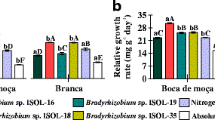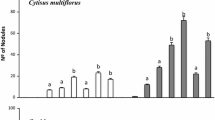Abstract
Two experiments were carried out to evaluate the effect of acidity on bean-Rhizobium competition for nodule sites. SevenPhaseolus vulgaris host cultivars differing in acid-pH tolerance were grown in sand culture, and irrigated using a sub-irrigation system and nutrient solutions of pH 4.5, 5.0, 5.5, and 6.0. A mixed inoculant of two antibiotically markedRhizobium leguminosarum bvphaseoli strains CIAT899 (acid-tolerant) and CIAT632 (acid-sensitive) was used. The acid-tolerant CIAT899 dominated CIAT632 in nodule occupancy across all cultivars and pH treatments. Although several of the varieties had previously been identified as PH-tolerant, and these cultivars performed better than those reported to be acid sensitive, all showed a marked increase in nodulation and plant development when the pH was raised from 4.5 to 6.0. The second experiment using a modified Leonard jar system varied the inoculation ratio between CIAT899 and UMR1116 (acid-sensitive, inefficient in N2-fixation) and contrasted nodulation response for the bean varieties ‘Preto 143’ (pH-tolerant) and ‘Negro Argel’ (pH-sensitive) at 3 pH treatments (4.5, 5.5, 6.5). There was a significant effect of host cultivar, ratio of inoculation, and pH on the percentage of nodule occupancy by each strain. At low pH CIAT899 had higher nodule occupancy than UM1116 in the variety ‘Negro Argel’ but had the same percentage of nodulation when the variety was ‘Preto 143’. Increasing the cell concentration of UMR1116 produced more inefficient nodules at all treatment combinations and reduced plant growth for both cultivars used.
Similar content being viewed by others
References
Blanchar R W and Lipton D S 1986 The pe and pH in alfalfa seedling rhizosphere. Agron. J. 78, 216–18.
Burton J C, Allen O N and Berger K C 1952 The prevalence of strains ofRhizobium phaseoli in some Midwestern soils. Soc. Sci. Soc. Am. Proc. 16, 167–170.
Caldwell B E and Vest G 1968 Nodulation interactions between Soybean genotypes and serogroups ofRhizobium japonicum. Crop Sci. 8, 680–82.
Cochran W G and Cox G M 1983. Diseños experimentales. Editorial Trillas, Mexico. 661 p, 1983.
Dughri M H and Bottomley P J 1983 Effect of acidity on the composition of an indigenous soil population ofRhizobium trifolii found in nodules ofTrifolium subterraneum L. Appl. Env. Microbiol. 46, 1207–13.
Dughri M H and Bottomley P J 1984 Soil acidity and the composition of an indigenous population ofRhizobium trifolii in nodules of different cultivars ofTrifolium subterraneum L. Soil Biol. Biochem. 16, 405–11.
Franco A A and Munns D N 1982 Acidity and aluminum restraint of nodulation, nitrogen fixation and growth ofPhaseolus vulgaris in solution culture. Soil Sci. Soc. Am. J. 46, 296–300.
Graham R A and Donawa A L 1981 Effect of soil pH and inoculum rate on shoot weight, nitrogenase activity and competitive nodulation of ground-nut (Arachis hypogeae, L.). Trop. Agric. 58, 337–40.
Graham P H 1963 Antibiotic sensitivities of the root-nodule bacteria. Aust. J. Biol. Sci. 16, 557–59.
Graham P H 1981 Some problems of nodulation and symbiotic nitrogen fixation inPhaseolus vulgaris L.: A review. Field Crops Res. 4, 93–112.
Graham P H, Viteri S E, Mackie F, Vargas A A T and Palacios A 1982 Variation in acid soil tolerance among strains ofRhizobium phaseoli. Field Crops Res. 5, 121–128.
Islam A K M S, Edwards D G and Asher C J 1980 pH optima for crop growth: Results of a flowing solution culture experiments with six species. Plant and Soil 54, 339–57.
Jones D G and Morley S J 1981 The effect of pH on host plant preference for strains ofRhizobium trifolium using fluorescent ELISA for strain identification. Ann. Appl. Biol. 97, 183–190.
Kim M K, Edwards D G and Asher C J 1985 Tolerance ofTrifolium subterraneum cultivars to low pH. Aust. J. Agric. Res. 36, 569–78.
Lovato P E, Pereira J C and Vidor C 1985 Population changes inRhizobium phaseoli strains in bean rhizosphere. R. bras. Ci. Solo 9, 211–18.
May S N and Bohlool B B 1983 Competition amongRhizobium leguminosarum strains for nodulation of lentils (Lens esculenta). Appl. Env. Microbiol. 45, 960–65.
Moore D P 1974 Physiological effects of pH on roots.In The Plant Root and the Environment. Ed. E W Carson, pp 135–51.
Pessanha G G, Franco A A, Dobereiner J, Groszmann A and Brito D P P S 1972 Negative correlation of nodulation and grain production of beans (Phaseolus vulgaris L.) in soils where nitrogen is not limiting factor of plant growth. Pesq. agropec. bras. 7, 49–56.
Robson A D and Loneragan J F 1970 Nodulation and growth ofMedicago trunculata on acid soils. II. Colonization of acid soils byRhizobium meliloti. Aust. J. Agric. Res. 21, 435–45.
Vargas A A T and Graham P H 1988Phaseolus vulgaris cultivar andRhizobium strain variation in acid-pH tolerance and nodulation under acid conditions. Field Crops Res. 19, 91–101.
Vincent J M and Waters L M 1953 The influence of the host on competition amongst clover root-nodule bacteria. J. Gen. Microbiol. 9, 357–70.
Vincent J M 1970 A Manual for the Practical Study of Root-Nodule Bacteria. IBP Handbook no. 15, Blackwell. 164 pages.
Voss M, Freire J R and Selbach P A 1984 Lime rates effect on soil and competition ability ofRhizobium phaseoli strains by nodule sites. Pesq. agropec. bras. 19, 433–39.
Author information
Authors and Affiliations
Rights and permissions
About this article
Cite this article
Vargas, A.A.T., Graham, P.H. Cultivar and pH effects on competition for nodule sites between isolates of Rhizobium in beans. Plant Soil 117, 195–200 (1989). https://doi.org/10.1007/BF02220712
Received:
Revised:
Issue Date:
DOI: https://doi.org/10.1007/BF02220712




